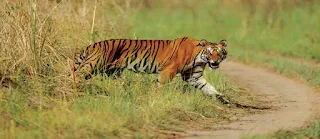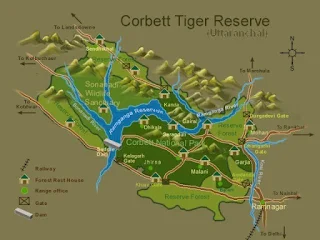Jim Corbett National Park is the oldest national park in India and was established in 1936 as Hailey National Park to protect the endangered Bengal tiger. It is located in Nainital district of Uttarakhand and was named after Jim Corbett who played a key role in its establishment. The park was the first to come under the Project Tiger initiative.
The park has sub-Himalayan belt geographical and ecological characteristics. An ecotourism destination, it contains 488 different species of plants and a diverse variety of fauna. The increase in tourist activities, among other problems, continues to present a serious challenge to the park's ecological balance.
Corbett has been a haunt for tourists and wildlife lovers for a long time. Tourism activity is only allowed in selected areas of Corbett Tiger Reserve so that people get an opportunity to see its splendid landscape and the diverse wildlife. In recent years the number of people coming here has increased dramatically. Presently, every season more than 70,000 visitors come to the park.
Corbett National Park comprises 520.8 km2 (201.1 sq mi) area of hills, riverine belts, marshy depressions, grasslands and a large lake. The elevation ranges from 1,300 to 4,000 ft (400 to 1,220 m). Winter nights are cold but the days are bright and sunny. It rains from July to September.
Dense moist deciduous forest mainly consists of sal, haldu, peepal, rohini and mango trees. Forest covers almost 73% of the park, 10% of the area consists of grasslands. It houses around 110 tree species, 50 species of mammals, 580 bird species and 25 reptile species.
The park has sub-Himalayan belt geographical and ecological characteristics. An ecotourism destination, it contains 488 different species of plants and a diverse variety of fauna. The increase in tourist activities, among other problems, continues to present a serious challenge to the park's ecological balance.
Corbett has been a haunt for tourists and wildlife lovers for a long time. Tourism activity is only allowed in selected areas of Corbett Tiger Reserve so that people get an opportunity to see its splendid landscape and the diverse wildlife. In recent years the number of people coming here has increased dramatically. Presently, every season more than 70,000 visitors come to the park.
Corbett National Park comprises 520.8 km2 (201.1 sq mi) area of hills, riverine belts, marshy depressions, grasslands and a large lake. The elevation ranges from 1,300 to 4,000 ft (400 to 1,220 m). Winter nights are cold but the days are bright and sunny. It rains from July to September.
Dense moist deciduous forest mainly consists of sal, haldu, peepal, rohini and mango trees. Forest covers almost 73% of the park, 10% of the area consists of grasslands. It houses around 110 tree species, 50 species of mammals, 580 bird species and 25 reptile species.
The park is located between 29°25' and 29°39'N latitude and between 78°44' and 79°07'E longitude. The altitude of the region ranges between 360 m (1,181 ft) and 1,040 m (3,412 ft). It has numerous ravines, ridges, minor streams and small plateaus with varying aspects and degrees of slope. The park encompasses the Patli Dun valley formed by the Ramganga river. It protects parts of the Upper Gangetic Plains moist deciduous forests and Himalayan subtropical pine forests ecoregions. It has a humid subtropical and highland climate.
The present area of the reserve is 1,318.54 square kilometers (509.09 sq mi) including 520 square kilometers (200 sq mi) of core area and 797.72 square kilometers (308.00 sq mi) of buffer area. The core area forms the Jim Corbett National Park while the buffer contains reserve forests (496.54 square kilometers (191.72 sq mi)) as well as the Sonanadi Wildlife Sanctuary (301.18 square kilometers (116.29 sq mi)).
The reserve, located partly along a valley between the Lesser Himalaya in the north and the Shivaliks in the south, has a sub-Himalayan belt structure. The upper tertiary rocks are exposed towards the base of the Shiwalik range and hard sandstone units form broad ridges. Characteristic longitudinal valleys, geographically termed Doons, or Duns can be seen formed along the narrow tectonic zones between lineaments
The weather in the park is temperate compared to most other protected areas of India. The temperature may vary from 5 °C (41 °F) to 30 °C (86 °F) during the winter and some mornings are foggy. Summer temperatures normally do not rise above 40 °C (104 °F).[16] Rainfall ranges from light during the dry season to heavy during the monsoons.
A total of 488 different species of plants have been recorded in the park. Tree density inside the reserve is higher in the areas of Sal forests and lowest in the Anogeissus-Acacia catechu forests. Total tree basal cover is greater in Sal dominated areas of woody vegetation. Healthy regeneration in sapling and seedling layers is occurring in the Mallotus philippensis, Jamun and Diospyros tomentosa communities, but in the Sal forests the regeneration of sapling and seedling is poor. More than 586 species of resident and migratory birds have been categorized, including the crested serpent eagle, blossom-headed parakeet and the red jungle fowl ancestor of all domestic fowl. 33 species of reptiles, seven species of amphibians, seven species of fish and 36 species of dragonflies have also been recorded. Bengal tigers, although plentiful, are not easily spotted due to the abundance of foliage - camouflage - in the reserve. Thick jungle, the Ramganga river and plentiful prey make this reserve an ideal habitat for tigers who are opportunistic feeders and prey upon a range of animals. The tigers in the park have been known to kill much larger animals such as buffalo and even elephant for food. The tigers prey upon the larger animals in rare cases of food shortage. There have been incidents of tigers attacking domestic animals in times of shortage of prey. Leopards are found in hilly areas but may also venture into the low land jungles. Small cats in the park include the jungle cat, fishing cat and leopard cat. Other mammals include barking deer, sambar deer, hog deer and chital, sloth and Himalayan black bears, Indian grey mongoose, otters, yellow-throated martens, Himalayan goral, Indian pangolins, and langur and rhesus macaques. Owls and nightjars can be heard during the night. In the summer, Indian elephants can be seen in herds of several hundred. The Indian python found in the reserve is a dangerous species, capable of killing a chital deer. Local crocodiles and gharials were saved from extinction by captive breeding programs that subsequently released crocodiles into the Ramganga river.
The present area of the reserve is 1,318.54 square kilometers (509.09 sq mi) including 520 square kilometers (200 sq mi) of core area and 797.72 square kilometers (308.00 sq mi) of buffer area. The core area forms the Jim Corbett National Park while the buffer contains reserve forests (496.54 square kilometers (191.72 sq mi)) as well as the Sonanadi Wildlife Sanctuary (301.18 square kilometers (116.29 sq mi)).
The reserve, located partly along a valley between the Lesser Himalaya in the north and the Shivaliks in the south, has a sub-Himalayan belt structure. The upper tertiary rocks are exposed towards the base of the Shiwalik range and hard sandstone units form broad ridges. Characteristic longitudinal valleys, geographically termed Doons, or Duns can be seen formed along the narrow tectonic zones between lineaments
The weather in the park is temperate compared to most other protected areas of India. The temperature may vary from 5 °C (41 °F) to 30 °C (86 °F) during the winter and some mornings are foggy. Summer temperatures normally do not rise above 40 °C (104 °F).[16] Rainfall ranges from light during the dry season to heavy during the monsoons.
A total of 488 different species of plants have been recorded in the park. Tree density inside the reserve is higher in the areas of Sal forests and lowest in the Anogeissus-Acacia catechu forests. Total tree basal cover is greater in Sal dominated areas of woody vegetation. Healthy regeneration in sapling and seedling layers is occurring in the Mallotus philippensis, Jamun and Diospyros tomentosa communities, but in the Sal forests the regeneration of sapling and seedling is poor. More than 586 species of resident and migratory birds have been categorized, including the crested serpent eagle, blossom-headed parakeet and the red jungle fowl ancestor of all domestic fowl. 33 species of reptiles, seven species of amphibians, seven species of fish and 36 species of dragonflies have also been recorded. Bengal tigers, although plentiful, are not easily spotted due to the abundance of foliage - camouflage - in the reserve. Thick jungle, the Ramganga river and plentiful prey make this reserve an ideal habitat for tigers who are opportunistic feeders and prey upon a range of animals. The tigers in the park have been known to kill much larger animals such as buffalo and even elephant for food. The tigers prey upon the larger animals in rare cases of food shortage. There have been incidents of tigers attacking domestic animals in times of shortage of prey. Leopards are found in hilly areas but may also venture into the low land jungles. Small cats in the park include the jungle cat, fishing cat and leopard cat. Other mammals include barking deer, sambar deer, hog deer and chital, sloth and Himalayan black bears, Indian grey mongoose, otters, yellow-throated martens, Himalayan goral, Indian pangolins, and langur and rhesus macaques. Owls and nightjars can be heard during the night. In the summer, Indian elephants can be seen in herds of several hundred. The Indian python found in the reserve is a dangerous species, capable of killing a chital deer. Local crocodiles and gharials were saved from extinction by captive breeding programs that subsequently released crocodiles into the Ramganga river.
Other attractions:-
- Dhikala is a well-known destination in the park and situated at the fringes of Patli Dun valley. There is a rest house, which was built hundred of years ago. Kanda ridge forms the backdrop, and from Dhikala, one can enjoy the spectacular natural beauty of the valley.
- Jeep Safari is the most convenient way to travel within the national park; jeeps can be rented for park trips from Ramnagar.
- Treks- tourists are not allowed to walk inside the park, but only to go trekking around the park in the company of a guide. The winter season is cold, so tourists should make proper arrangements for their clothing, if they are traveling in the winter season.
- Walking Safaris are possible in the buffer zone areas - and very rewarding with Corbett having a very healthy and lush, rich buffer zone around; look for lodges around with trained staff for the same.
- Kalagarh Dam is dam located in the south-west of the wildlife sanctuary. This is one of the best places for a bird watching tour. Lots of migratory waterfowl comes here in the winters.
- Corbett Falls is a 20 m (66 ft) water fall situated 25 km (16 mi) from Ramnagar, and 4 km (2.5 mi) from Kaladhungi, on the Kaladhungi–Ramnagar highway. The water falls is surrounded by dense forests and pin drop silence.
- Garjiya Devi Temple is sacred to Garjiya Devi and is mostly visited by the traveller during the Kartik Poornima (November – December). It is a prominent temple located on the bank of river Kosi, amidst the hilly terrains of Uttarakhand, nearby Garjiya village, at a distance of 14 km. from Ramnagar, Uttarakhand, India








































No comments:
Post a Comment
Stay updated with our blog for more quality content! Your feedback is appreciated. Contact us at harshrex@outlook.com with any suggestions.